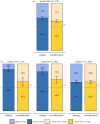Across demographics and recent history, most parents sing to their infants and toddlers daily
- PMID: 34719251
- PMCID: PMC8558774
- DOI: 10.1098/rstb.2021.0089
Across demographics and recent history, most parents sing to their infants and toddlers daily
Abstract
Music is universally prevalent in human society and is a salient component of the lives of young families. Here, we studied the frequency of singing and playing recorded music in the home using surveys of parents with infants (N = 945). We found that most parents sing to their infant on a daily basis and the frequency of infant-directed singing is unrelated to parents' income or ethnicity. Two reliable individual differences emerged, however: (i) fathers sing less than mothers and (ii) as infants grow older, parents sing less. Moreover, the latter effect of child age was specific to singing and was not reflected in reports of the frequency of playing recorded music. Last, we meta-analysed reports of the frequency of infant-directed singing and found little change in its frequency over the past 30 years, despite substantial changes in the technological environment in the home. These findings, consistent with theories of the psychological functions of music, in general, and infant-directed singing, in particular, demonstrate the everyday nature of music in infancy. This article is part of the theme issue 'Voice modulation: from origin and mechanism to social impact (Part I)'.
Keywords: infancy; music; parenting; sex differences; universality.
Figures



Similar articles
-
Music therapy enhances preterm infant's signs of engagement and sustains maternal singing in the NICU.Infant Behav Dev. 2021 Aug;64:101596. doi: 10.1016/j.infbeh.2021.101596. Epub 2021 Jun 9. Infant Behav Dev. 2021. PMID: 34118653
-
Acoustic parameters of infant-directed singing in mothers with depressive symptoms.Infant Behav Dev. 2011 Apr;34(2):248-56. doi: 10.1016/j.infbeh.2010.12.013. Epub 2011 Jan 20. Infant Behav Dev. 2011. PMID: 21255845
-
The effects of mothers' singing on full-term and preterm infants and maternal emotional responses.J Music Ther. 2008 Fall;45(3):273-306. doi: 10.1093/jmt/45.3.273. J Music Ther. 2008. PMID: 18959452 Clinical Trial.
-
Musical predispositions in infancy.Ann N Y Acad Sci. 2001 Jun;930:1-16. doi: 10.1111/j.1749-6632.2001.tb05721.x. Ann N Y Acad Sci. 2001. PMID: 11458822 Review.
-
"Need for interventional studies on the impact of music in the perinatal period: results of a pilot study on women's preferences and review of the literature".J Matern Fetal Neonatal Med. 2013 Mar;26(4):357-62. doi: 10.3109/14767058.2012.733763. Epub 2012 Nov 1. J Matern Fetal Neonatal Med. 2013. PMID: 23039049 Review.
Cited by
-
Everyday Parameters for Episode-to-Episode Dynamics in the Daily Music of Infancy.Cogn Sci. 2022 Aug;46(8):e13178. doi: 10.1111/cogs.13178. Cogn Sci. 2022. PMID: 35938844 Free PMC article.
-
Voice modulation: from origin and mechanism to social impact.Philos Trans R Soc Lond B Biol Sci. 2021 Dec 20;376(1840):20200386. doi: 10.1098/rstb.2020.0386. Epub 2021 Nov 1. Philos Trans R Soc Lond B Biol Sci. 2021. PMID: 34719255 Free PMC article.
-
Children infer the behavioral contexts of unfamiliar foreign songs.J Exp Psychol Gen. 2023 Mar;152(3):839-850. doi: 10.1037/xge0001289. Epub 2022 Oct 10. J Exp Psychol Gen. 2023. PMID: 36222671 Free PMC article.
-
Ecological Momentary Assessment Reveals Causal Effects of Music Enrichment on Infant Mood.Child Dev. 2025 Jul-Aug;96(4):1555-1567. doi: 10.1111/cdev.14246. Epub 2025 May 28. Child Dev. 2025. PMID: 40432545 Free PMC article. Clinical Trial.
-
Nocturnal selective pressures on the evolution of human musicality as a missing piece of the adaptationist puzzle.Front Psychol. 2023 Oct 4;14:1215481. doi: 10.3389/fpsyg.2023.1215481. eCollection 2023. Front Psychol. 2023. PMID: 37860295 Free PMC article.
References
-
- Trehub SE, Trainor L. 1998. Singing to infants: lullabies and play songs. Adv. Infancy Res. 12, 43-78.
-
- Papousek M. 1996. Intuitive parenting: a hidden source of musical stimulation in infancy. In Musical beginnings: origins and development of musical competence (eds Deliage I, Sloboda J), pp. 88-112. New York, NY: Oxford University Press. (10.1093/acprof:oso/9780198523321.003.0004) - DOI
-
- Falk D. 2009. Finding our tongues: mothers, infants and the origins of language. New York, NY: Basic Books. See http://www.aspresolver.com/aspresolver.asp?ANTH;1677184.
Publication types
MeSH terms
Associated data
Grants and funding
LinkOut - more resources
Full Text Sources
Miscellaneous

